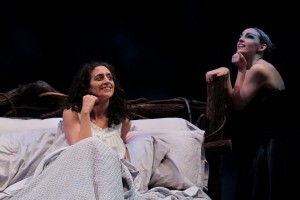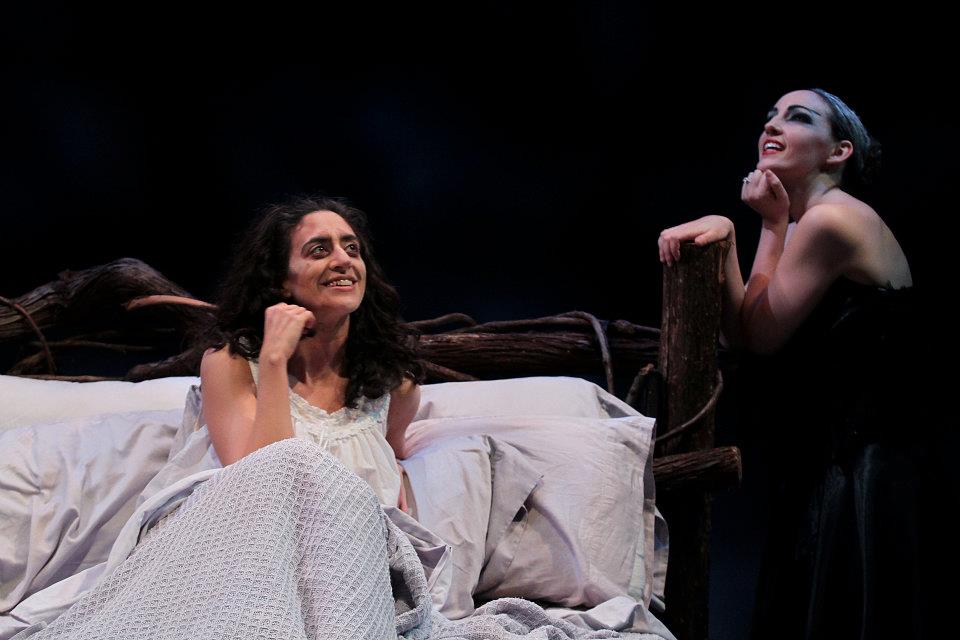
Felicia Leicht (Woman) and Jessica O'Brien (Scarecrow) in Villanova Theatre's Philadelphia premiere of WOMAN AND SCARECROW, a mesmerizing new play by Ireland's leading female playwright, Marina Carr. This production marks the beginning of Villanova University's partnership with The Abbey Theatre, National Theatre of Ireland and runs through November 20. (Photo credit: Paola Nogueras)
Villanova University’s highly respected Theatre Department is beginning an exchange program with Ireland’s celebrated Abbey Theatre; the two institutions will be working together to further enrich their artistic and intellectual traditions. Students from Villanova will be afforded the opportunity to study with the Abbey in Dublin and artists from there will spend time at the University. There will be lectures, workshops and community conversations as the University offers a “home away from home” for the Abbey. The inaugural event in this exchange is the Theatre’s production of Marina Carr’s WOMAN AND SCARECROW, onstage at Vasey Hall November 8th thru the 20th.
Death—and dying; the Irish (and I am one) seem to be obsessed with this topic. Don’t know why this is, but it is a subject oft explored in the theatre of my heritage. Ms. Carr’s 2006 play is no exception. Granted, death is unavoidable—it’s going to happen to all of us, there’s not much we can do about it. And yet, my people manage to find the humor in this matter—albeit, dark humor, but humor nonetheless. (My family certainly has—it’s what has gotten us through many difficult times). I guess that’s what surprises so many people: that you find yourself laughing as you watch this compelling—and “painterly”—piece of theatre.
Of course, you also find yourself thinking a lot, too…
In an interview from 2001, Ms. Carr is quoted as saying “The fact that we are dying probably is the only significant thing for all of us. And how we live, and how we die. I think that is so important—how one dies… It is the only significant thing about us—that we are going to die, and that we get it so wrong.” WOMAN AND SCARECROW is Ms. Carr’s attempt to force us all to think about things we don’t really want to: Do we want to know if we are dying? Will we be brave as our life seeps out of us? Will we be honest? Will we have a chance to say all the things we were afraid to tell the ones we love?
In the play, which is influenced by the works of Beckett, Yeats and Shakespeare, we are in the bedroom of a woman who is in the last moments of her life. Her age is unclear, but it is evident that she will be leaving too soon. Her illness is never specified, yet her physical suffering is clear. As she looks back on the events of her life, you learn of her regrets and see her fear of what will become of her eight children, who will be left in the care of their detached and philandering father.

Felicia Leicht and Jessica O'Brien in a scene from Marina Carr's WOMAN AND SCARECROW, running at Villanova Theatre's Vasey Hall through November 20. (Photo credit: Paola Nogueras)
There the connection to reality ends; for present throughout most of the two acts is the figure of the Scarecrow—a representation of a Gaelic mythological figure, The Morrígan. In Irish legend, the scarecrow is a powerful figure; birds are associated with prophecy and serve as messengers from the immortal world. The viewer is left to wonder is this enigmatic figure a drug-induced figment of the Woman’s imagination or her guardian angel there to protect her to the end.
Felicia Leicht gives a riveting performance as “Woman”, running a gamut of emotions: remorse, longing, love, bitterness… She plays the gallows humor of the character perfectly (at one point Woman looks at her wasted away appearance in a hand mirror and reacts with joy at her “graveyard chic”). Ms. Leicht has a remarkable command of the material; I wasn’t sure if a college student would have that well of life experience to draw upon that would help convey the characters mindset. Ms. Leicht grabs the viewer and doesn’t let go.
Jessica O’Brien matches her as “Scarecrow”, alternating between oddly comforting friend and cruel prosecutor. Her movement throughout was fascinating to watch as well—conveying both that of a bird and a lyricism and grace. Woman has had little if any happiness in her brief life—a fact that Scarecrow takes great pains to drive home. Any time Woman wants to romanticize anything, O’Brien’s character is there to force her to face the truth about her loveless life. These two young actresses take the viewer on a roller coaster ride—with as many twists and turns.
Lizzy Dalton-Negron appears as the woman’s stern and very judgmental Auntie Ah. To me, the character represents the moral rigidity of the Catholic Church. She raised the woman after her own mother’s early death; one imagines how cold and immovable she was to this lost little girl. Ms. Dalton-Negron conveys that detached unthinking acceptance and regurgitation of Church dogma quite well. My only question was why she was the only cast member with a hint of an Irish accent. The other three performers don’t affect a brogue and it isn’t really needed as the story is so universal.

Production values run high in Villanova Theatre's production of WOMAN AND SCARECROW. Felicia Leicht and Jessica O'Brien play the leading roles. (Photo credit: Paola Nogueras)
Ahren Potratz has the most thankless role of the play: Woman’s philandering husband. It is very telling that the script refers to the character as “Him”. Mr. Potratz portrays a man who is annoyed that the woman he impregnated 8 times is taking so long to die—and keeping him from his latest mistress. It must be very difficult as an actor to go to that place emotionally. Yet Mr. Potratz gives a full-bodied performance, with a couple of momentary glimpses of the gentle part that attracted Woman in the first place. The fact that they spend so little of the time left attempting to come to terms with their situation was very disturbing to me, though, I must admit. But, then, I have a lot of personal baggage in that area…
Director Fr. David Cregan (a former actor himself) has staged this play beautifully, eliciting wonderfully calibrated performances in this nicely paced production. It is clear that much background work was done to assist this young cast in mining the depths of this material. He is supported magnificently by the design work. Scenic designer Vandy Scoates has created a simple yet evocative playing space in the Vasey’s very deep thrust. From the faded wood planking of the raked floor to the over-large armoire upstage, one is given the feeling of an old Irish “council house”. The large bed of entwined branches adds the element of other worldliness. Jerrold Forsyth’s lighting enhances this effect perfectly. There is some marvelous light projections and shadow play on the upstage wall throughout the piece. Parris Bradley’s sound design includes powerful versions of the music of Dvorak and Demis Roussos that the playwright references in her script. Costumer Valerie Cavooris beautifully blends the look of practical Irish wear with Scarecrow’s esoteric ensemble that references the designs of the late Alexander McQueen. Other influences that emerge in the team’s work include Salvador Dali, Dorothea Tanning and Ron Mueck.
This play is a challenging evening of theatre for both the performers and the viewer—it does not give easy answers. Yet there is tremendous humor in Ms. Carr’s dialogue; it is sharp and witty as it takes the audience on a most intriguing journey. It was one I found most enjoyable.
WOMAN AND SCARECROW
by Marina Carr
Directed by Rev. David Cregan, O.S.A.
November 8-20, 2011
Villanova Theatre-Vasey Hall
Lancaster & Ithan Avenues
Villanova, PA
610-519-7474
www.villanovatheatre.org



4 comments
Ms. Dalton-Negron affects an Irish accent because she is Australian.
I thought the above was an interesting comment in an Irish play. And, an interesting review that set me thinking.
Wouldn’t it be more likely the entire cast might have a bit of an Irish brogue that might come out a time or two? As the character that does have the Irish accent, she is the one representing the struggle of life, is she not? I admit not to seeing this play, but it would seem if a director had to choose to have an entire cast without accent in a decidedly Irish play with Irish images and background, having a significant character with one would make her stand out logically. Since you saw the show and it is your educated opinion, it wasn’t needed–that’s certainly your call.
I get the Irish thing a lot since I, too, am Irish with the fair hair and all. I’ve travelled to Australian and discovered the Irish community quite thriving–including radio stations in that promote the Gaelic culture.
My personal favorite role is that of Hogan in MOON FOR THE MISBEGOTTEN where he uses his heavy-at-times brogue for controlling the moment. BTW, as a reviewer, I nail ’em when they don’t use it.
Marie- That still doesn’t answer the basic question… If Ms. Negron is unable to take her accent to the same region as the others, then bring the others to her as much as possible so that there is a unity to the piece. It was a jarring note in an otherwise wonderful symphony.
Jack–I too am Irish. I am also a dialect coach and have, on occassion, “nailed” productions for poor accent work. It is a rare case when I will say that having the appropriate regional accent isn’t crucial. In the case of this particular play, it was so esoteric that I wasn’t offended by not having brogues present. Ms Negron’s obviously different speech just stuck out for me.
If it doesn’t stick out for you in a way that enhances the play then it doesn’t work. What about the rest of the audience? Are you the only one there? Because a play is for an audience of more than one. I should think your standards are not necessarily the audience standards anymore than they expect you to adapt theirs. In your perspective, it doesn’t work. And if the playwright objects, of course, but hopefully we all get something out of the play.